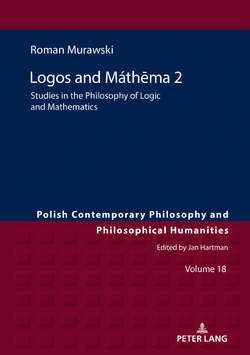Читать книгу Lógos and Máthma 2 - Roman Murawski - Страница 11
На сайте Литреса книга снята с продажи.
Hilbert’s program
ОглавлениеOne of the reactions on the crisis in the foundations of mathematics on the turn of the 19th century was Hilbert’s program. Hilbert’s aim was to save the integrity of classical mathematics (dealingwith actual infinity) by showing that it is secure.1 He saw also the supra-mathematical significance of this issue. In 1926 he wrote: “The definite clarification of the nature of the infinite has become necessary, not merely for the special interests of the individual sciences, but for the honor of human understanding itself ”. Being first of all a mathematician, he “had little patience with philosophy, his own philosophy of mathematics being perhaps best described as naïve optimism – a faith in the mathematician’s ability to solve any problem he might set for himself ” (cf. Smoryński 1988).
Hilbert’s program of clarification and justification of mathematics was Kantian in character (cf. Detlefsen 1993). Following Kant, he claimed that the mathematician’s infinity does not correspond to anything in the physical world, that it is “an idea of pure reason” – as Kant used to say. On the other hand, Hilbert wrote in (1926):
Kant taught – and it is an integral part of his doctrine – that mathematics treats a subject matter which is given independently of logic. Mathematics, therefore can never be grounded solely on logic. Consequently, Frege’s and Dedekind’s attempts to so ground it were doomed to failure.
As a further precondition for using logical deduction and carrying out logical operations, something must be given in conception, viz., certain extralogical concrete objects which are intuited as directly experienced prior to all thinking. For logical deduction to be certain, we must be able to see every aspect of these objects, and their properties, differences, sequences, and contiguities must be given, together with the objects themselves, as ←11 | 12→something which cannot be reduced to something else and which requires no reduction. This is the basic philosophy which I find necessary not just for mathematics, but for all scientific thinking, understanding and communicating. The subject matter of mathematics is, in accordance with this theory, the concrete symbols themselves whose structure is immediately clear and recognizable.2
According to this, Hilbert distinguished between the unproblematic, finitistic part of mathematics and the infinitistic part which needed justification. Finitistic mathematics deals with so-called real sentences, which are completely meaningful because they refer only to given concrete objects. Infinitistic mathematics on the other hand deals with so-called ideal sentences that contain reference to infinite totalities. Hilbert believed that every true finitary proposition had a finitary proof. Infinitistic objects and methods played only an auxiliary role. They enabled us to give easier, shorter and more elegant proofs but every such proof could be replaced by a finitary one. He was convinced that consistency implies existence and that every proof of existence not giving a construction of postulated objects is in fact a presage of such a construction.
Unfortunately, Hilbert did not give a precise definition of finitism – one finds by him only some hints how to understand it. Hence various interpretations are possible (cf., e.g. Detlefsen 1979; Prawitz 1983; Resnik 1974; Smorynski 1988; Tait 1981).
The infinitistic mathematics can be justified only by finitistic methods because only they can give it security (Sicherheit). Hilbert’s proposal was to base mathematics on finitistic mathematics via proof theory. Its main goal was to show that proofs which use ideal elements in order to prove results in the real part of mathematics always yield correct results. We can distinguish here two aspects: consistency ←12 | 13→problem and conservation problem3.The former consists in showing (by finitistic methods) that the infinitistic mathematics is consistent, and the latter – in showing (again by finitistic methods) that any real sentence which can be proved in the infinitistic part of mathematics can be proved also in the finitistic part, i.e. that infinitistic mathematics is conservative over finitistic mathematics with respect to real sentences and, even more, that there is a finitistic method of translating infinitistic proofs of real sentences into finitistic ones.4
Hilbert wanted to solve those problems via his proof theory. His proposal to carry out the program consisted of two steps: 1. to formalize mathematics, i.e., to reconstruct infinitistic mathematics as a big, elaborate formal system and 2. to give a proof of the consistency and conservativeness of mathematics. It should be done by finitistic methods, and it was possible since after formalization one could treat formulas of the system of mathematics as strings of symbols and proofs as strings of formulas (i.e., as strings of strings of symbols).
